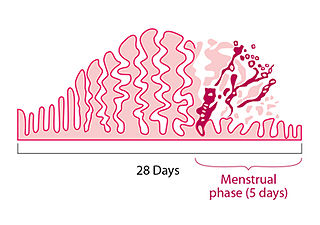This article needs additional citations for verification .(April 2017) |
An anovulatory cycle is a menstrual cycle characterised by the absence of ovulation and a luteal phase. It may also vary in duration from a regular menstrual cycle.
This article needs additional citations for verification .(April 2017) |
An anovulatory cycle is a menstrual cycle characterised by the absence of ovulation and a luteal phase. It may also vary in duration from a regular menstrual cycle.
While the normal human menstrual cycle typically lasts 4 weeks (28 days, range 24–35 days) and consists of a follicular phase, ovulation, and a luteal phase followed by either menstruation or pregnancy, the anovulatory cycle has cycle lengths of varying degrees. In many circumstances, menstrual intervals are prolonged, reaching 35–180 days (oligomenorrhea) or even longer (amenorrhea). In other cases, menstruation may be fairly regular (eumenorrhea), more frequent (intervals of less than 21 days) or there may be a loss of menstrual pattern (menorrhagia, dysfunctional uterine bleeding).
Normal menstrual bleeding in the ovulatory cycle is a result of a decline in progesterone due to the demise of the corpus luteum. It is thus a progesterone withdrawal bleed. As there is no progesterone in the anovulatory cycle, bleeding is caused by the inability of estrogen—which needs to be present to stimulate the endometrium in the first place—to support a growing endometrium. Anovulatory bleeding is hence termed 'estrogen breakthrough bleeding'.
A physician needs to investigate the cause of anovulation. Common causes are:
With excessive or prolonged bleeding the diagnosis has to be made by a physician on a speedy basis. Other causes of gynecological bleeding need to be excluded, specifically bleeding related to pregnancy, leiomyoma, and cancer of the cervix or uterus.
Women who do not ovulate and who want to get pregnant need a medical work-up to find out why they do not ovulate. Drugs are often given to induce ovulation, including oral medication such as clomiphene or injectable medications. In patients who do not want to get pregnant anovulation can be managed with the use of cyclic progesterone or progestin supplementation or use of hormonal contraception.

The endometrium is the inner epithelial layer, along with its mucous membrane, of the mammalian uterus. It has a basal layer and a functional layer: the basal layer contains stem cells which regenerate the functional layer. The functional layer thickens and then is shed during menstruation in humans and some other mammals, including other apes, Old World monkeys, some species of bat, the elephant shrew and the Cairo spiny mouse. In most other mammals, the endometrium is reabsorbed in the estrous cycle. During pregnancy, the glands and blood vessels in the endometrium further increase in size and number. Vascular spaces fuse and become interconnected, forming the placenta, which supplies oxygen and nutrition to the embryo and fetus. The speculated presence of an endometrial microbiota has been argued against.
Calendar-based methods are various methods of estimating a woman's likelihood of fertility, based on a record of the length of previous menstrual cycles. Various methods are known as the Knaus–Ogino method and the rhythm method. The standard days method is also considered a calendar-based method, because when using it, a woman tracks the days of her menstrual cycle without observing her physical fertility signs. The standard days method is based on a fixed formula taking into consideration the timing of ovulation, the functional life of the sperm and the ovum, and the resulting likelihood of pregnancy on particular days of the menstrual cycle. These methods may be used to achieve pregnancy by timing unprotected intercourse for days identified as fertile, or to avoid pregnancy by avoiding unprotected intercourse during fertile days.

Menstruation is the regular discharge of blood and mucosal tissue from the inner lining of the uterus through the vagina. The menstrual cycle is characterized by the rise and fall of hormones. Menstruation is triggered by falling progesterone levels and is a sign that pregnancy has not occurred.

The menstrual cycle is a series of natural changes in hormone production and the structures of the uterus and ovaries of the female reproductive system that makes pregnancy possible. The ovarian cycle controls the production and release of eggs and the cyclic release of estrogen and progesterone. The uterine cycle governs the preparation and maintenance of the lining of the uterus (womb) to receive an embryo. These cycles are concurrent and coordinated, normally last between 21 and 35 days, with a median length of 28 days, and continue for about 30–45 years.

Ovulation is the release of eggs from the ovaries. In women, this event occurs when the ovarian follicles rupture and release the secondary oocyte ovarian cells. After ovulation, during the luteal phase, the egg will be available to be fertilized by sperm. In addition, the uterine lining (endometrium) is thickened to be able to receive a fertilized egg. If no conception occurs, the uterine lining as well as the egg will be shed during menstruation.
Gynecologic hemorrhage represents excessive bleeding of the female reproductive system. Such bleeding could be visible or external, namely bleeding from the vagina, or it could be internal into the pelvic cavity or form a hematoma. Normal menstruation is not considered a gynecologic hemorrhage, as it is not excessive. Hemorrhage associated with a pregnant state or during delivery is an obstetrical hemorrhage.
Anovulation is when the ovaries do not release an oocyte during a menstrual cycle. Therefore, ovulation does not take place. However, a woman who does not ovulate at each menstrual cycle is not necessarily going through menopause. Chronic anovulation is a common cause of infertility.
Abnormal uterine bleeding (AUB), also known as atypical vaginal bleeding (AVB), is vaginal bleeding from the uterus that is abnormally frequent, lasts excessively long, is heavier than normal, or is irregular. The term dysfunctional uterine bleeding was used when no underlying cause was present. Vaginal bleeding during pregnancy is excluded. Iron deficiency anemia may occur and quality of life may be negatively affected.

Vaginal bleeding is any expulsion of blood from the vagina. This bleeding may originate from the uterus, vaginal wall, or cervix. Generally, it is either part of a normal menstrual cycle or is caused by hormonal or other problems of the reproductive system, such as abnormal uterine bleeding.
Basal body temperature is the lowest body temperature attained during rest. It is usually estimated by a temperature measurement immediately after awakening and before any physical activity has been undertaken. This will lead to a somewhat higher value than the true BBT.

The menstrual cycle is on average 28 days in length. It begins with menses during the follicular phase, followed by ovulation and ending with the luteal phase. Unlike the follicular phase which can vary in length among individuals, the luteal phase is typically fixed at approximately 14 days and is characterized by changes to hormone levels, such as an increase in progesterone and estrogen levels, decrease in gonadotropins such as follicle-stimulating hormone (FSH) and luteinizing hormone (LH), changes to the endometrial lining to promote implantation of the fertilized egg, and development of the corpus luteum. In the absence of fertilization by sperm, the corpus luteum degenerates leading to a decrease in progesterone and estrogen, an increase in FSH and LH, and shedding of the endometrial lining (menses) to begin the menstrual cycle again.
Intermenstrual bleeding (IMB) is vaginal bleeding at irregular intervals between expected menstrual periods. It may be associated with bleeding with sexual intercourse.

A menstrual disorder is characterized as any abnormal condition with regards to a woman's menstrual cycle. There are many different types of menstrual disorders that vary with signs and symptoms, including pain during menstruation, heavy bleeding, or absence of menstruation. Normal variations can occur in menstrual patterns but generally menstrual disorders can also include periods that come sooner than 21 days apart, more than 3 months apart, or last more than 10 days in duration. Variations of the menstrual cycle are mainly caused by the immaturity of the hypothalamic-pituitary-ovarian (HPO) axis, and early detection and management is required in order to minimize the possibility of complications regarding future reproductive ability.
Polymenorrhea, also known as frequent periods, frequent menstruation, or frequent menstrual bleeding, is a menstrual disorder in which menstrual cycles are shorter than 21 days in length and hence where menstruation occurs more frequently than usual. Cycles are regular and menstrual flow is normal in the condition. Normally, menstrual cycles are 25 to 30 days in length, with a median duration of 28 days.
Ovulation induction is the stimulation of ovulation by medication. It is usually used in the sense of stimulation of the development of ovarian follicles to reverse anovulation or oligoovulation.

Dydrogesterone, sold under the brand name Dydroboon & Duphaston among others, is a progestin medication which is used for a variety of indications, including threatened or recurrent miscarriage during pregnancy, dysfunctional bleeding, infertility due to luteal insufficiency, dysmenorrhea, endometriosis, secondary amenorrhea, irregular cycles, premenstrual syndrome, and as a component of menopausal hormone therapy. It is taken by mouth.

Relative energy deficiency in sport (RED-S) is a syndrome in which disordered eating, amenorrhoea/oligomenorrhoea, and decreased bone mineral density are present. It is caused by eating too little food to support the amount of energy being expended by an athlete, often at the urging of a coach or other authority figure who believes that athletes are more likely to win competitions when they have an extremely lean body type. RED-S is a serious illness with lifelong health consequences and can potentially be fatal.
Hypomenorrhea or hypomenorrhoea, also known as short or scanty periods, is extremely light menstrual blood flow. It is the opposite of heavy periods or hypermenorrhea which is more properly called menorrhagia.

Catamenial epilepsy is a form of epilepsy in women where seizures are exacerbated during certain phases of the menstrual cycle. In rare cases, seizures occur only during certain parts of the cycle; in most cases, seizures occur more frequently during certain parts of the cycle. Catamenial epilepsy is underlain by hormonal fluctuations of the menstrual cycle where estrogens promote seizures and progesterone counteracts seizure activity.
Infertility in polycystic ovary disease (PCOS) is a hormonal imbalance in women that is thought to be one of the leading causes of female infertility. Polycystic ovary syndrome causes more than 75% of cases of anovulatory infertility.